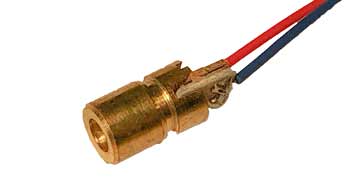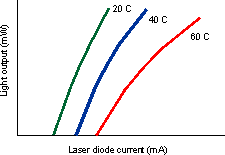Laser Diode Specifications & Characteristics Explained
Understand what you need to know about laser diode specifications & characteristics: how they relate to real circuits & applications with top tips on the precautions to be considered.
Home » Electronic components » this page
Laser Diode Includes:
Laser diode basics
Specifications
Other diodes: Diode types
When using a laser diode it is essential to know its performance characteristics because they can easily be destroyed if the circuit conditions are not right.
Accordingly it is necessary to understand the main laser diode specifications and characteristics and how they can relate to real electronic circuit designs.

Like any electronics components, many of the specifications are relatively generic and are applicable to any form of semiconductor diode, but other parameters will tend to be more focussed on the particular component. This is true for laser diode specifications and characteristics.
There are a number of laser diode specifications, or laser diode characteristics that are key to the overall performance and these are outlined.
Laser diode L/I characteristic
One of the most commonly used and important laser diode specifications or characteristics is its L/I curve. This plots the drive current supplied on the horizontal axis against the light output on the vertical axis.
This laser diode specification is used to determine the current required to obtain a particular level of light output at a given current. It can also be seen that the light output is also very dependent upon the temperature and this can be important for some circuit designs.

It can be seen from this that as the temperature rises, the light output falls. This can be very important in circuits that use feedback to maintain the light output because circuitry needs to be in place to monitor the temerpature to ensure that the diode does not become overheated, which could destroy it.
It can also be seen from this characteristic that there is a threshold current below which the laser action does not take place.
The laser diode should be operated clear of this point to ensure reliable operation over the full operating temperature range as the threshold current rises with increasing temperature.
It is typically found that the laser threshold current rises exponentially with temperature, and therefore this must be accommodated in the circuit design, bearing in mind that the diode should not be over-stressed.
Laser diode V/I specification
The laser diode specification for the forward voltage across the diode is required in a number of areas of the electronic circuit design. Often laser diode manufacturers prefer to place the voltage on the vertical axis, rather than the more normal horizontal axis for voltage.

From the diagram it can be seen that the voltage across the laser diode is typically around 1.5 volts, although it is necessary to check the specification for the particular laser diode in being considered.
The forward voltage specification will vary according to the materials used in the diode, current, etc.
Although the forward voltage does vary with temperature, this is not normally a major consideration, although the circuit design will need to accomodate this, ideally without changing the current and hence the light output power and its frequency.
Operating current, Iop
The operating current is a key parameter for any laser diode as it details the current that needs to be supplied to ensure the correct operation.
The operating current is the level of forward current that is required to be supplied toth e laser diode to produce the specified laser output and this is given for a particular temperature because this affects a number of the operating parameters.
Operating voltage Vop
Although the operating current is the main factor that needs to be controlled to provide the required output and it must be limited to prevent burning the device out, the operating voltage Vop is also very important and it is often needed in some circuit design calculations.
The forward voltage across the laser diode occurs when the diode produces its specified laser output at a specified operating temperature.
This figure can help any electronic circuit designer to ensure that the required current can be provided with the required voltage drop across the diode.
Optical output power, Po
The optical output power from the device, Po is important because it is necessary to ensure that the laser diode has the right optical output power for the function required.,?p>Some applications may only require a low output power whereas others will need a much higher power.
Accordingly it is necessary to select the diode with the right output power for the given application.
The optical output power is often specified as the maximum permissible instantaneous optical power output and this can be valid for both continuous and pulsed modes of operation.
Laser diode efficiency characteristic
It is possible to deduce the laser diode efficiency parameter from the L/I curve. However it is easier to visualise when plotted separately. In view of the importance of the laser diode efficiency this is often usefully plotted.
The plot of the laser diode efficiency characteristic will show that the efficiency falls with increasing temperature. A typical laser diode specification for efficiency will be around 0.3 mW per mA at around 25°C and will fall by about 0.01 for each 10°C increase.
Laser diode tracking ratio characteristic
Many laser diode packages include a second photo diode to monitor the output of the laser. In this way the output power of the laser can be controlled and stabilised - the output from the monitor diode is fed back into the laser diode control and drive circuitry.
Normally the unwanted light exiting from the back face of the laser diode is used for the measurement as this light cannot be used elsewhere.
In order for the laser output to be accurately controlled it is necessary for the monitor diode to accurately track the laser diode output.
The monitor photodiode current is directly proportional to the light output from the laser and therefore a figure known as the tracing ratio is used. Measured in mA/mW it is the ratio of the photodiode current in milliamps compared to the laser diode light output in milliwatts.
Many laser diodes come in a package which includes an integral photo-diode sensor. These packages have additional leads for the laser diode and the sensor diode.
Reverse voltage specification
Laser diodes are easily damaged by reverse voltages. It is therefore unwise to allow the laser diode to be reverse biased.
Maximum reverse currents of 10µA are typically the maximum reverse current levels tolerated.
Laser diode far-field beam pattern
The pattern for the beam of light emitted is an important laser diode specification from an optical viewpoint.
The light emanating from the diode itself is not collimated, but it is typically in the form of an oval cone of light. The ellipticity occurs because the emission area or aperture of the diode occurs as a slit in the plane parallel to the junction.
The divergence of the light beam are measured at the half maximum light power angles in the axes perpendicular and parallel to the active region of the laser diode.
Typical values are 30° and 12° for the two angles of the elliptical cone.
Laser diodes single / multimode
Laser diodes may be specified as being either single or multimode. These two types of laser diode are generally used for different applications.
Whether a laser diode is single mode or multimode is governed by the geometry of the laser diode itself. In the vertical direction, the light is contained in a very thin layer, and the structure supports only a single optical mode of operation in the direction perpendicular to the layers.
However if the waveguide is wide compared to the wavelength of light in the lateral direction, then the waveguide can support multiple lateral optical modes, and the laser is known as a "multi-mode" laser diode.
Multimode laser diodes tend to be used where high power is required and a larger laser diode is required to accommodate the higher power levels.
In applications where a small focused beam is needed, the waveguide must be made narrow when compared to the wavelength of the light being generated. As a result the laser diode can only support a single lateral mode. The beam created is then diffraction-limited in terms of its dispersion.
These single mode laser diodes are used for optical storage, laser pointers, and fiber optics. Note that these lasers may still support multiple longitudinal modes, and thus can lase at multiple wavelengths simultaneously.
Rise time
Many laser diodes are used in applications where they need to be switched on and off. One example may be for fibre optic communications. One of the aspects that will limit their bandwidth when operating in a switched mode is the rise time.
The rise time is defined as the time required for the optical output from the diode to rise from 10 percent to 90 percent of its maximum value.
The rise time specification will not be important for some applications , but for others where bandwidth is important, it will be absolutely key.
Laser diode wavelength, λ, specification
The wavelength for the light emitted is one of the key parameters within the datasheet. It will determine many of the applications for which the laser diode can be used.
The 'lasing' or laser diode wavelength is normally specified in nm - nanometres.
While other forms of laser may be able to provide a stable signal in terms of the wavelength, laser diodes are notoriously poor in this respect. They are affected by both the drive current and the temperature. Changes in temperature affect the bandgap, and hence the gain frequency profile of the junction.
Typical figures for wavelength variations with respect to voltage may be around 0.1 to 0.5 nm/°C, but this is very dependent upon the device, its frequency and a number of other considerations.
The specifications might be slightly different for single and multimode lasers:
Single mode laser wavelength: The wavelength quoted for a single mode laser will be the wavelength of the single spectral line at a given temperature and operating current.
Multiple mode laser wavelength: The wavelength quoted for a multiple mode device will be the spectral line with the greatest density. Again this will be quoted for the conditions including current and temperature.
It is worth noting that the wavelength of the light emitted from a semiconductor laser diode is sensitive to both operating current and temperature. careful control of both is needed of the wavelength is to be accurately maintained.
it is particularly important that the power supply is well regulated and free from noise and transient spikes. Power supply noise can increase the phase noise on the light and along with frequency drift, this can degrade the performance of systems such as fibre optic links, etc..
Operating Temperature Range
One of the key aspects of the operation of a laser diode is the operating temperature range. As they dissipate heat and excessive temerpature can result in damage, care needs to be excercised when running these devices to esnrue that they do not become too hot, otherwise reliability and lifetime will fall.
The operating temperature is the range of the case temperature for which the laser device may be safely operated.
Packages
Laser diodes come in a variety of different packages. They do not come as the basic diode in the same way that ordinary PN junction diodes, LEDs or the like come. Instead laser diodes often have a metal case that enables heat to be transferred away from the device itself.
In addition to this, the packages often contain extra elements such as a sensor photo-diode for sensing the output level, or they may have other elements added toth e package to ensure that the overall laser diode module has sufficient on-board capability.
The packages also, typically, incorporate a glass cover to protect the overall internal assembly from dirt and moisture ingress.
ESD precautions
May be it is not a specification as such, but it is worth remembering that laser diodes are quite sensitive to static. As a result it is very important to employ general ESD precautions.
Static sensitive mats, wrist straps, and ESD proof soldering equipment are all needed when handling these devices.
Damage resulting from static discharges could destroy the device, or possibly worse they could introduce latent damage which could result in them failing later when they are in service.
When laser diodes are used in electronic circuits, it is necessary to understand, not only the standard specifications that might be applicable to any semiconductor diode, but also the ones that are important for the operation of a laser diode in its intended function.
These specifications relate to the operation of the diode as a laser, and it is important not to over stress the component otherwise failure could easily result.
 Written by Ian Poole .
Written by Ian Poole .
Experienced electronics engineer and author.
More Electronic Components:
Batteries
Capacitors
Connectors
ADC
DAC
Diodes
FET
Inductors
Memory types
Phototransistor
Quartz crystals
Relays
Resistors
RF connectors
Switches
Surface mount technology
Thyristor
Transformers
Transistor
Unijunction
Valves / Tubes
Return to Components menu . . .



